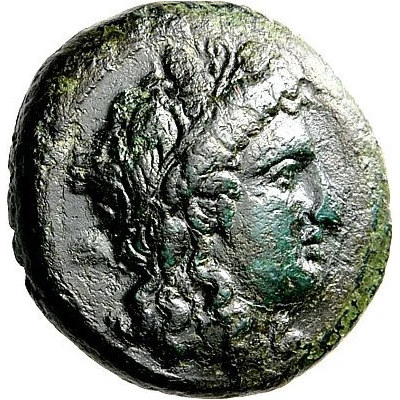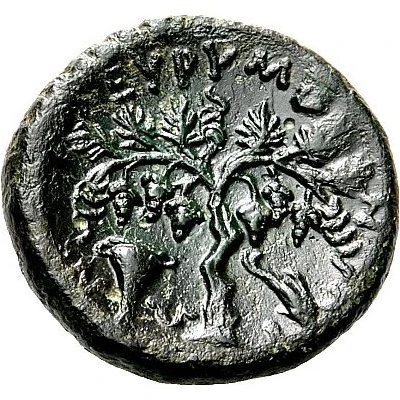


© Nomos AG
Trichalkon 352 BC - 344 BC
| Bronze | 7.02 g | 20.0 mm |
| Issuer | Eurymenai (Thessaly) |
|---|---|
| Type | Standard circulation coin |
| Years | 352 BC - 344 BC |
| Value | Trichalkon (1⁄16) |
| Currency | Drachm |
| Composition | Bronze |
| Weight | 7.02 g |
| Diameter | 20.0 mm |
| Shape | Round (irregular) |
| Technique | Hammered |
| Demonetized | Yes |
| Updated | 2024-10-10 |
| Numista | N#170726 |
|---|---|
| Rarity index | 100% |
Reverse
Grape vine with leaves and six bunches of grapes. To the right of the trunk, dolphin swimming downwards. To the left, krater
Script: Greek
Lettering: ΕΥΡΥΜΕΝΑΙΩΝ
Comment
Traité IV, 753, pl. CCCI, 2.
Interesting fact
The Trichalkon coin was used in ancient Greece during the 4th century BC and was known for its unique design, featuring three nails or spikes on one side, which gave it its name (Trichalkon means "three nails" in Greek). This design was meant to symbolize the three cities that issued the coin: Eurymenai, Phthiotic Thebes, and Thessalian Thebes. The coin was also unique in that it was made of bronze, which was a less valuable metal than silver or gold, but was still widely used for currency at the time. Despite its relatively low value, the Trichalkon coin was an important part of ancient Greek commerce and trade, and many examples have been found in archaeological excavations throughout the region.
Price
| Date | Mintage | VG | F | VF | XF | AU | UNC |
|---|---|---|---|---|---|---|---|
| ND (352 BC - 344 BC) | - | - | - | - | - | - |
Values in the table are based on evaluations by sales realized on Internet platforms. They serve as an indication only for Trichalkon (352 BC - 344 BC) coin.